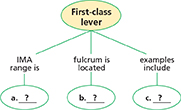14.4 Simple Machines
Reading Focus
Key Concepts
 What are the six types of simple machines?
What are the six types of simple machines? What determines the mechanical advantage of the six types of simple machines?
What determines the mechanical advantage of the six types of simple machines?
Vocabulary
lever
fulcrum
input arm
output arm
wheel and axle
inclined plane
wedge
screw
pulley
compound machine
Reading Strategy
Summarizing After reading the section on levers, complete the concept map below to organize what you know about first-class levers. Construct and complete similar concept maps for second- and third-class levers.

What can you say about the workings of the strange contraption shown in Figure 12? Notice that a series of devices are arranged so that output of one device acts as the input of the next.
Many mechanical devices are combinations of two or more of the six different simple machines.  The six types of simple machines are the lever, the wheel and axle, the inclined plane, the wedge, the screw, and the pulley. As you'll learn, you can tell a lot about a simple machine by its appearance. For several machines, you can even calculate the ideal mechanical advantage based solely on the locations of the forces involved.
The six types of simple machines are the lever, the wheel and axle, the inclined plane, the wedge, the screw, and the pulley. As you'll learn, you can tell a lot about a simple machine by its appearance. For several machines, you can even calculate the ideal mechanical advantage based solely on the locations of the forces involved.
Figure 12 The idea for this labor-saving auto jack comes from Rube Goldberg (1883–1970), a sculptor, author, and Pulitzer Prize-winning cartoonist.
 d
d



